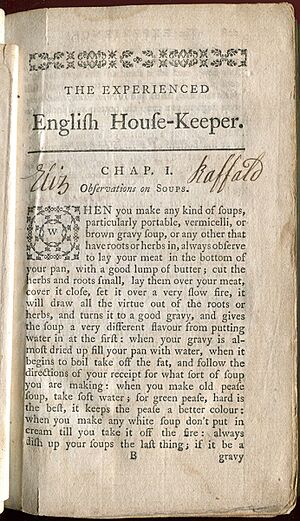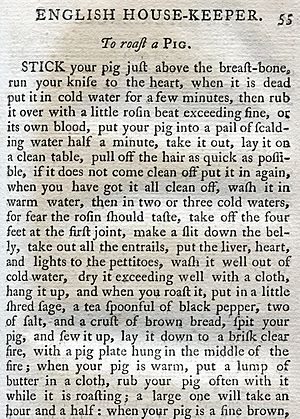The Experienced English Housekeeper facts for kids

Title page, 1775 edition
|
|
| Author | Elizabeth Raffald |
|---|---|
| Country | England |
| Subject | English cooking |
| Genre | Cookery |
| Publisher | Elizabeth Raffald Sold by R. Baldwin |
|
Publication date
|
1769 |
| Pages | 397 |
The Experienced English Housekeeper is a famous cookery book written by an English businesswoman named Elizabeth Raffald (1733–1781). It was first published in 1769. This book became very popular, with 13 official versions and at least 23 copied (or "pirated") versions.
The book contains about 900 recipes. These include recipes for soups, main dishes like roasted and boiled meats, puddings, and fish. It also has ideas for desserts, table decorations, and small savory dishes. You can also find recipes for potted meats, drinks, wines, pickles, preserves, and distilled essences. The recipes are mostly direct instructions, without lists of ingredients. The book has three fold-out pictures made from copper plates.
This cookbook is known for being very practical. Unlike older cookbooks, it didn't copy recipes from other books. Instead, it used Elizabeth Raffald's own cooking experience. It also has the first known recipe for a wedding cake covered in marzipan and royal icing. The book also mentions barbecue very early on. Today, it is still a helpful book for people who write about cooking.
Contents
About the Author
Elizabeth Raffald was born in Doncaster, England, in 1733. From 1748 to 1763, she worked as a housekeeper for several important families. One of these was the Warburton family at Arley Hall in Cheshire. There, she met John Rafford, who was the head gardener and later became her husband.
In 1763, Elizabeth and John moved to Manchester. Elizabeth opened a sweet shop, and John sold flowers and seeds. They had 16 children, all girls! Besides her cookbook, Elizabeth also wrote a book about midwifery (helping with childbirth). She also ran an office in Manchester that helped servants find jobs. In 1773, she sold the rights to her book to her publisher for £1400. This amount would be worth a lot more money today.
Elizabeth Raffald wrote in her book's introduction that she worked as a housekeeper for "great and worthy families." She also said she traveled with them, which helped her learn even more. People who study old books say she was one of the most famous English cookbook writers of her time, after Hannah Glasse.
Inside the Book
What's in The Experienced English Housekeeper?
The book is divided into three main parts. Here's a look at what each part covers:
- Part I: Soups, Meats, Fish, Pies, and Puddings
- Chapter 1: Soups
- Chapter 2: Dressing Fish
- Chapter 3: Roasting and Boiling
- Chapter 4: Made Dishes (like stews or casseroles)
- Chapter 5: Pies
- Chapter 6: Puddings
- Part II: Desserts and Other Dishes
- Chapter 7: Making Decorations for a Table
- Chapter 8: Preserving (like making jams)
- Chapter 9: Drying and Candying
- Chapter 10: Creams, Custards, and Cheese-Cakes
- Chapter 11: Cakes
- Chapter 12: Little Savory Dishes
- Part III: Preserves, Pickles, Wines, and Essences
- Chapter 13: Potting and Collaring (ways to preserve meat)
- Chapter 14: Possets, Gruel, &c. (drinks and simple foods)
- Chapter 15: Wines, Catchup, and Vinegar
- Chapter 16: Pickling
- Chapter 17: Keeping Garden-Stuff, and Fruit
- Chapter 18: Distilling (making essences)
The book also includes a list of foods that are in season each month. It also has directions for setting a "Grand Table" and an index.
How the Recipes Are Written
The book starts with a dedication to Lady Elizabeth Warburton and a preface. It also has a fold-out picture of a stove. To stop people from copying her book illegally, Elizabeth Raffald signed each real copy. She also printed a note on the title page saying, "N. B. No Book is genuine but what is signed by the Author."
Each chapter begins with "Observations" or tips on the topic. For example, the chapter on roasting and boiling has advice like, "when you boil mutton or beef, observe to dredge them well with flour before you put them into the kettle of cold water."
The rest of each chapter is full of "receipts" (which we call recipes today). These are usually instructions like "To roast a Pig" or "To make Sauce for a Pig." Sometimes, there's a small comment, like "A nice way to dress a Cold Fowl."
Most dish names are in English, even if the dish came from another country. For example, "To make Cream Cakes" is the recipe for meringue. It starts by saying, "Beat the whites of nine eggs to a stiff froth."
However, Raffald did use some foreign words for new cooking methods. Examples include "to fricassee Lamb Stones" or "to barbecue a Pig." She explained that she used French names for some dishes because that's how they were known. She also promised that these dishes wouldn't be too expensive or complicated.
The recipes are written as direct instructions. They don't list ingredients separately. They assume the cook knows basic things, like how to beat eggs or make pastry. Here's an example of a recipe for sago pudding:
A SAGO PUDDING another way.
Boil two ounces of sago till it is quite thick in milk, beat six eggs, leaving out three of the whites, put to it half a pint of cream, two spoonfuls of sack, nutmeg and sugar to your taste; put a paste round your dish.
Pictures in the Book
The official versions of the book had three fold-out pictures. One showed a stove. The other two showed how to arrange a table for the first and second courses of a meal. Raffald wanted to make it easy for young housekeepers to understand. She said she had these "copper-plates" made because she wanted to make sure "even the weakest capacity" could understand her instructions.
The book helped people learn how to serve an elegant meal in the French style. The pictures showed a table with 25 "prettily-shaped" dishes arranged neatly. Each dish was labeled with the name of the recipe.
The second course table layout included dishes like:
- Pheasant
- Snow balls
- Crawfish in savory jelly
- Moonshine
- Pickl'd Smelts
- Marbl'd Veal
- Fish pond
- Mince Pies
- Globes of gold web with mottoes in them
- Stewed Cardoon
- Pompadore Cream
- Roast Woodcocks
- Transparent pudding covered with a silver web
- Pea Chick with asparagus
- Maccaroni
- Stew'd mushrooms
- Pistacha Cream
- Crocrant with Hot Pippins
- Floating Island
- Collared Pig
- Pott'd Lampreys
- Rocky Island
- Snipes in savory jelly
- Burnt Cream
- Roast'd Hare
The Book's Impact
How it Influenced Others
The Experienced English Housekeeper was very successful. It had 13 official editions and at least 23 illegal copies. To fight against these copies, Elizabeth Raffald signed each real book by hand. She also printed a warning on the title page. In 1773, she sold the rights to her book to her publisher.
Because her book was so popular, other "experienced housekeepers" tried to publish their own cooking advice books. For example, Sarah Martin published The New Experienced English Housekeeper in 1795. Susanna Carter also wrote The Experienced Cook and Housekeeper's Guide in 1822.
Firsts in the Book
The Experienced English Housekeeper was the first book to include a recipe for what we now know as the classic wedding cake. This recipe included both marzipan and royal icing.
The Oxford English Dictionary (a very old and important dictionary) said in 1888 that Raffald's book was one of the first English sources to mention barbecue in cooking.
Modern Cookery Connection
The Cambridge Guide to Women's Writing in English noted that Raffald's book was special because it came purely from her own cooking experience. She even apologized for her "plainness of the style" in her introduction. However, this simple and clear writing is what makes her book still appealing today. Her clear style is similar to that of another famous cookbook writer, Eliza Acton, who wrote a century later.
The famous cookery writer Sophie Grigson shared that her mother, Jane Grigson, used to make Raffald's Orange Custards every year. It was a special treat when Seville oranges were in season.
In 2013, Arley Hall, where Elizabeth Raffald used to work, started serving some of her recipes again. These included lamb pie, pea soup, and rice pudding. However, the general manager said they would not be making her turtle or calf's foot pudding!
How the Book Was Published
Elizabeth Raffald wrote in her preface that she personally checked every page as it was printed. She said she had a neighbor print it whom she could trust. She was happy with the finished book and thanked her friends and the people who subscribed to buy the book early. Over 800 people supported her, which was more than she expected. This means she was a self-publisher, printing her own book.
Official Editions
The official versions of the book were mostly published in London. Here are some of them:
- 2nd Edition, 1771
- 3rd Edition, 1773
- 4th Edition, 1775
- 5th Edition, 1776
- 7th Edition, 1780
- 8th Edition, 1782
- 9th Edition, 1784
- 11th Edition, 1794
- 12th Edition, 1799
- New Edition, 1801
- 13th Edition, 1806
Other Editions
Many unofficial copies were made in Britain and America. Some examples include:
- London: A. Millar, W. Law & R. Cater, 1787
- London: W. Osborne & T. Griffin, 1794
- Manchester: G. Bancks, 1798
- York: T. Wilson & R. Spence, 1803
- London: Brambles, Meggitt and Waters, 1805
See also
 In Spanish: La experimentada ama de llaves inglesa para niños
In Spanish: La experimentada ama de llaves inglesa para niños




